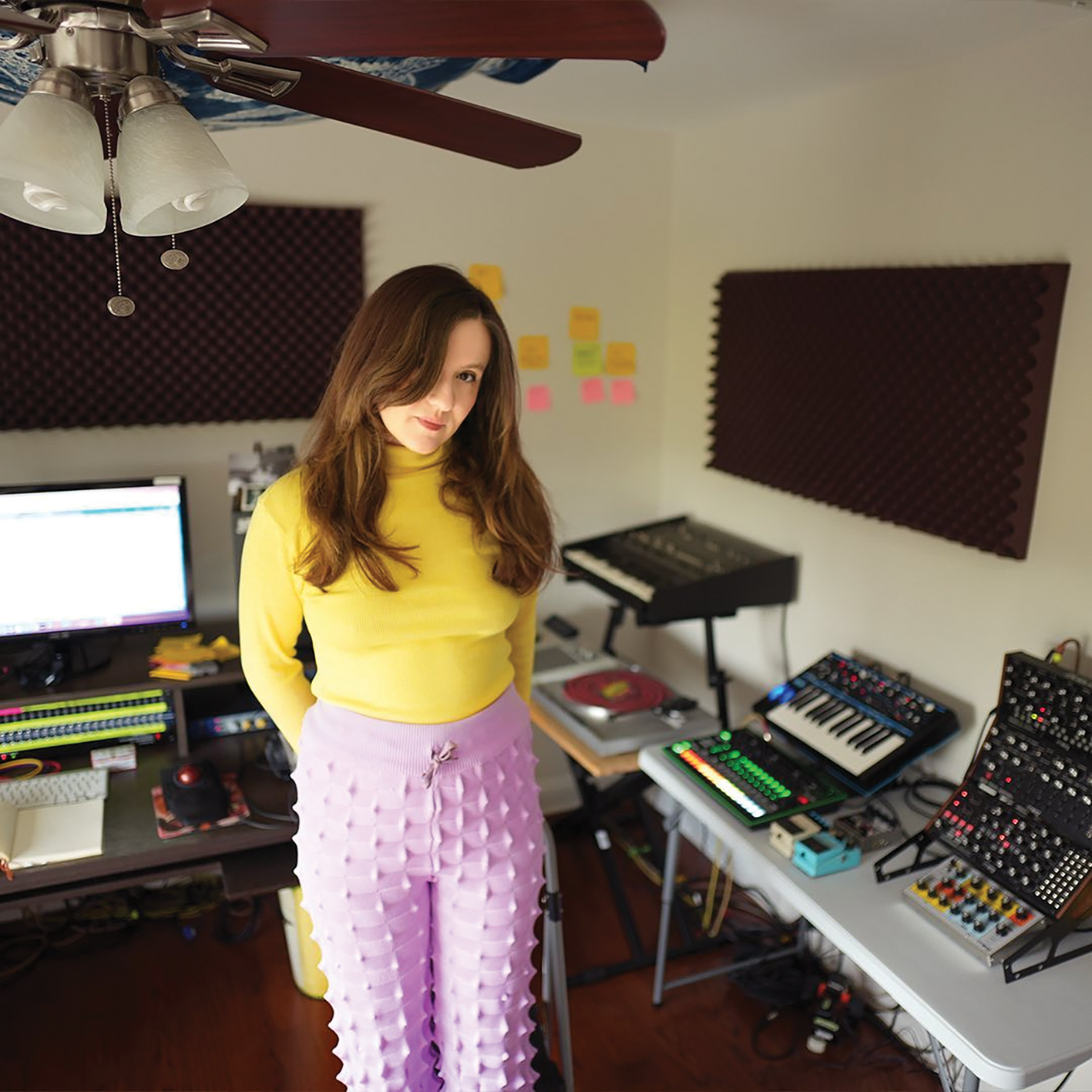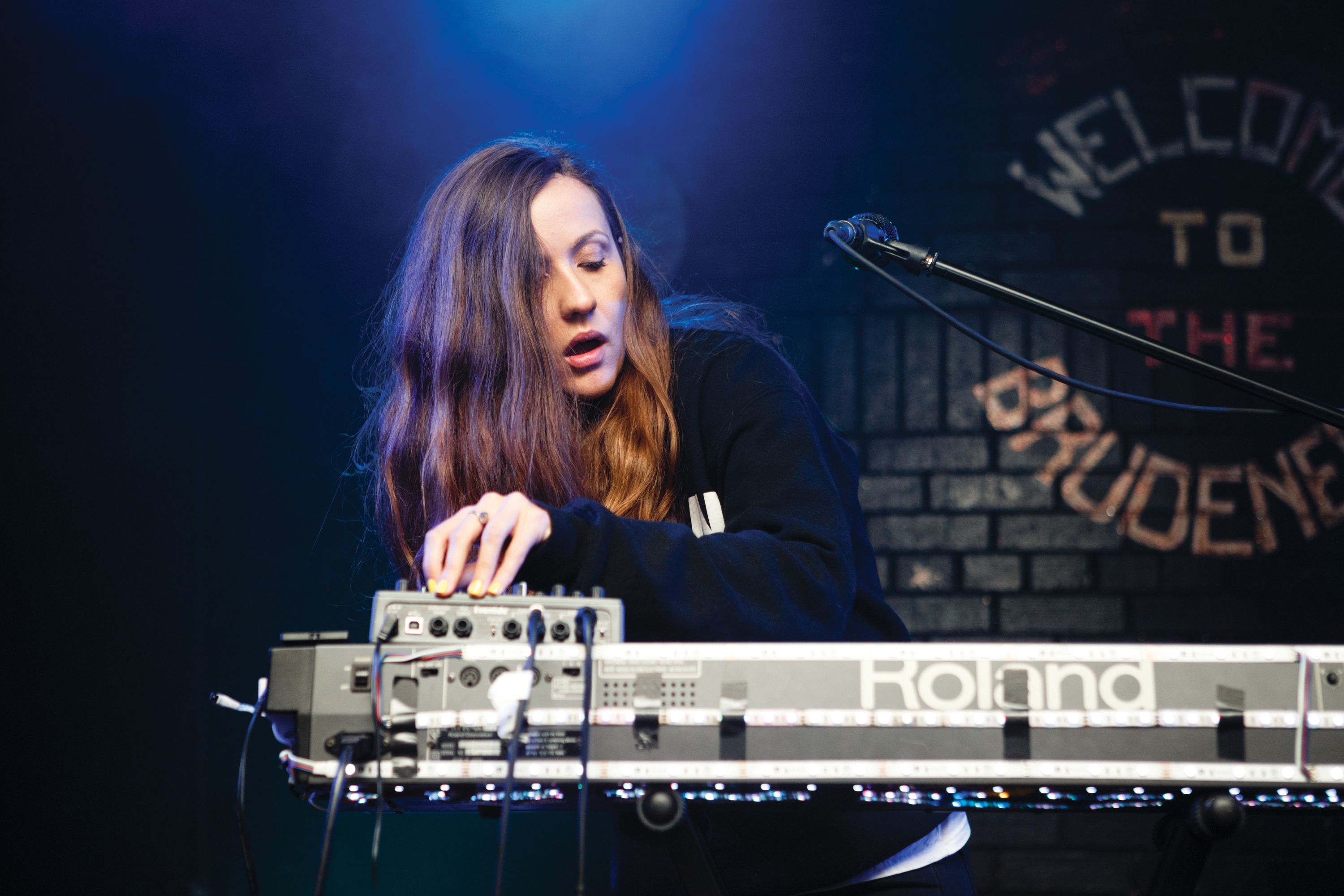Jessy Lanza on the Roland Aerophone, recording in a treehouse and losing a Juno at the airport
Meet the Canadian producer adding a strange, techno twist to neo-soul with new album Love Hallucination

Jessy Lanza is one of those people who has spent much of her life in or around her hometown and has a particular relationship with it. Hamilton, Ontario is just over the Canadian border from Niagara Falls, on the shore of Lake Ontario, and also hemmed in by Lakes Huron and Erie. Much bigger cities like Toronto and Detroit are nearby – we’re talking North American distances, not European – but so is the Canadian wilderness.
“You don’t have to go far out of Hamilton to be in the middle of nowhere,” laughs the 37-year-old producer. “When you commune with nature in Canada, it can sometimes feel kinda overwhelming. There was a sense of space and melancholy that definitely filtered down into the music I make… songs with a sense of longing.”
Those songs were first gathered on Lanza’s acclaimed 2013 debut album, Pull My Hair Back, co-produced by Junior Boys’ Jeremy Greenspan, who just happened to be a Hamilton neighbour of Lanza’s. An album of burbling, ethereal soul set to a pared-down, almost techno-y soundtrack, Pull My Hair Back made the shortlist for that year’s Polaris Music Prize (Canada’s version of the Mercury Music Prize) and led to a collaboration with another Ontario native, the Grammy-nominated Caribou.
Lanza had definitely made her mark. Two more albums – 2016’s Oh No and 2020’s All The Time – were followed by a spiffing DJ-Kicks collection in 2021, but recording became increasingly difficult after Lanza moved out of her family home because… well, she no longer had a studio.
“Although you can do a lot inside the computer, I still like to use my analogue and modular synths,” Lanza explains further. “Writing, for me, is often about sitting in the studio for a few days, recording everything that happens. When you don’t have a permanent setup, that isn’t easy.”
After leaving Hamilton, Lanza moved to San Francisco, then New York for a while, then London, stayed with friends, and recently set up home in LA. The latest album, Love Hallucination, was literally put together on the hoof. Most of the vocals were recorded 10 feet off the ground in her brother-in-law’s childhood treehouse in San Francisco.
A treehouse? Was that another attempt to commune with nature?
Get the MusicRadar Newsletter
Want all the hottest music and gear news, reviews, deals, features and more, direct to your inbox? Sign up here.
“I suppose it did feel a bit like that. Sharing my space with birds and other wildlife. The room was actually much nicer than it sounds – a luxury treehouse – but recording the vocals did create a few problems. I gathered every spare duvet I could lay my hands on and had them covering the walls. Trying to get some sort of soundproofing. In the end, it didn’t really matter because the vocals got so messed around once they were in the computer. I wasn’t looking for the perfect ‘one take’ vocal. In fact, I don’t think I’ve ever done a perfect one-take vocal in my life. Part of the fun of recording is seeing how creative I can be with my finished vocals.”
Creative with effects plugins or just tinkering around with the audio?
“A bit of both. Digging into the audio and pulling out the bits that I like, then really getting right down into the waveforms. The main plugin that I tend to use for vocals is iZotope’s Iris. Some people might find that a little odd because Iris is a sampler rather than an actual effect plugin. These days, though, the jobs kind of cross over. You can put a piece of audio into Iris, then dial into the waveform and do all sorts of crazy stuff. EQ, filtering, pitch… it’s a whole rack of effects.”
Did writing and recording in all of those different places affect the sound of this new album? Your previous albums seemed to have had a lot of analogue input… the Juno, Polymoog, some vintage drum machines. Did they get left behind during all of the studio moves?
“Y’know what, it didn’t really affect things at all. Well, it affected the recording process, but it didn’t affect the music. Songs got started in Logic and Ableton on the computer, but then I was lucky enough to spend time with Jeremy [Greenspan] in his studio. He’s got a whole room full of great synths. I also worked with David Kennedy [aka Pearson Sound] at his London studio. I still had access to some analogue gear even though most of mine was in storage for five years.
“I’m pretty much settled in LA now and I don’t think I’ll be moving for a while, so I got my gear back from the storage guys earlier this year. Even though it had been in the one place, some of it still refused to work. I guess that’s what you expect with analogue synths. And what made things even worse was when I did try to take my Juno on the road for a few dates, the airline actually lost it.”

Losing your undies and socks is bad enough, but losing a Juno!
“I was desperately trying to explain what it was and how important it was to me, and all the sounds I’d got saved in there. After a month, they finally located it. I was reminded of those stories about DJs checking in a box of treasured vinyl at the airport and never seeing it again.”
You came to electronic music via classical, jazz and ’80s R&B. Not the most obvious route.
“My parents were into music and my dad was kind of involved in the music business. He had a studio setup at home and ran a PA company. They wanted me to learn an instrument, so I did what my parents wanted. I studied classical piano and played a lot of clarinet. Emotionally, I didn’t really connect with music while I was studying; I suppose I was just going through the motions. But I did enjoy the competitions because they gave me a chance to ‘perform’. They were so frightening! You’re a young kid, getting on a stage in front of a hall full of people, trying to steady your nerves and play music.”
When it came to making electronic music, did all of the classical studying help or did it get in the way?
“No, it definitely helped. OK, you have to be careful because you can get carried away by theory. That’s the progression I want, but it’s against the rules, so I must change it. But what those years really taught me to do was listen. Especially when I started concentrating on jazz rather than classical. Why do those chords work? Why does that bassline work? When I first started recording, I made a lot of mistakes because I was simply trying to emulate the songs I liked. Luckily, I was a good listener and, bit by bit, I was able to shape the music the way I wanted.”
Did you know how you wanted your music to sound?
“Ha ha! This is the crazy thing… I had no idea. There was that vague idea of melancholy I was talking about. And space. So much of my early songwriting was about stripping things down, making room for the song instead of trying to fill up every second with noise.
Logic and Ableton both have their strengths and weaknesses, but Ableton’s File Tree really annoys me
“A big moment for me was hearing Lifestyles of the Laptop Café, a 2001 album by The Other People Place. [Released via Warp, the album was put together by Detroit producer, James Stinson, also part of the hugely influential Detroit/Michigan collective, Underground Resistance. Sadly, Stinson died a year after its release, aged just 33.] It’s an album of ‘proper songs’ with vocals, but they completely tear up the rulebook when it comes to structure and space. That album made me realise you can write songs with texture, as well as melodies and words.”
Coming up via classical and jazz – lots of theories and finger exercises! – how easy did you find it to make music on a computer?
“It was difficult at first because I was figuring out all this stuff on my own. I was using a few of my dad’s old synths and drum machines, but I had to rely on someone with a computer and a DAW to actually record stuff. Some of my early experiences were unpleasant. People who thought they knew what my music needed better than I did. From what my friends tell me, that has been a problem in the music business for many, many years.
“But then I met Kode9 [aka Scottish producer Steve Goodman, founder of the Hyperdub label which has been home to all of Lanza’s releases]. He was the first person from the electronic scene who really gave me the time of day. And then I started working with Jeremy Greenspan at his studio in Hamilton, another key moment for me. Jeremy was also kind enough to set me up with a copy of Logic, which allowed me to finally take control of my own music and ideas. It was the wonderful moment that I’m sure every electronic music producer experiences: I no longer have to rely on anyone else.”
Are you still with Logic?
“Logic for most of the work, Ableton for live and maybe getting ideas down if I’m in a hurry. They both have their strengths and weaknesses, but Ableton’s File Tree really annoys me.”
It’s sometimes those small things that make all the difference to whether you feel comfortable with a DAW.
“I’m glad you said that because I wondered if I was just being picky. One of the issues I’ve had to really address over the last few years while I was moving from place to place was my admin skills. I would open up hard drives and I’d have all of these files with stupid names like, AAA, JJJJJJ, JJJJJJ2, THING. The entire drums from the first single on the new album, Don’t Leave Me Now, came from one of those lost files. I couldn’t even remember where or how I made them. My top tip? Label all your files in a way that lets you know what they are. You give it some vague name and, five years down the line, you have no idea what’s in there.”

Are the live version of the songs different to what we hear on the album?
“Right from the start, I was always worried about how I could make a live show exciting for me and the audience. The vocals on the album are so heavily processed that there was no point in trying to recreate them on stage, but I’ve got a bunch of Eventide pedals that give me something to play with. I spend a lot of time dialling in the settings for different songs and then get Ableton to spit out all the info.”
You’ve started playing clarinet on stage. Can you tell us what led to that move?
“It’s actually the Roland Aerophone. I have to admit that it was a complete revelation for me, playing an instrument on stage instead of standing by the computer, looking like I’m answering my emails. I felt so much more engaged with the music, which I hope comes across to the audience. Even just being at home and practising scales was quite exhilarating.”
Can we expect a Kenny G duet?
“Ha ha! The clarinet sounds aren’t great, but the sax is pretty good. Who knows what the future holds? At heart, I am an old school soul-jazz-R&B girl. Think about what was happening with ’80s R&B. You’d got dance music and soul coming into contact with all the new technology like sequencers, synths and drum machines. What’s not to like?”
Is that what you were listening to when you made this album?
“Always. And my favourite album of this year is Sundown by Eddie Chacon. You remember Charles & Eddie? ‘Would I lie to you baby?’. Sadly, Charles died in 2001 and it seems that Eddie really struggled with that loss for many years. This feels like a powerful, redemptive album. A real reminder of how much emotion music can carry. Wait till I tell you the song that first made me take notice of dance music… Saturday Night by Whigfield. I must have been seven or eight and I used to get so excited when the video came on TV. I’m sure people will laugh at me, but I don’t care. It’s a great, great pop song.”


“Excels at unique modulated timbres, atonal drones and microtonal sequences that reinvent themselves each time you dare to touch the synth”: Soma Laboratories Lyra-4 review
e-instruments’ Slower is the laidback software instrument that could put your music on the fast track to success









